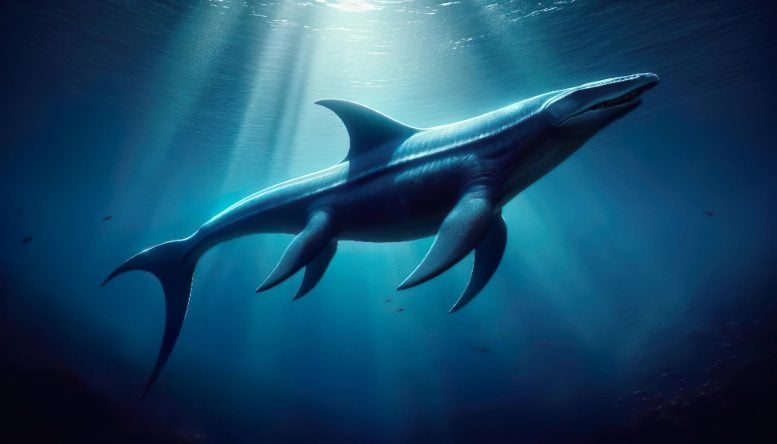Ancient Seas Plagued by a 72 Million-Year-Old "Dragon"

The Wakayama Soryu, a mosasaur that was recently discovered in Japan, has sparked interest among researchers due to its unique physical features and comparable size to the great white shark. This enormous marine reptile lived around 72 million years ago and was characterized by its elongated rear flippers and a dorsal fin similar to that of a shark. This discovery, which has been named Megapterygius wakayamaensis, has raised new questions regarding the hunting and swimming behaviors of mosasaurs. The credit for this significant discovery goes to SciTechDaily.com.
A group of researchers has carried out an extensive study on a mosasaur that was discovered in Japan, which ruled the Pacific waters about 72 million years ago and was approximately the size of a great white shark.
This particular mosasaur species differed from other large extinct marine reptiles as it possessed an extended dorsal fin similar to a shark, which would have allowed it to make quick and precise turns in water. Moreover, this creature benefitted from lengthy rear flippers which contributed to enhanced propulsion when combined with its elongated finned tail.
The mosasaur has been comprehensively documented by University of Cincinnati Associate Professor Takuya Konishi and his international co-authors in the Journal of Systematic Palaeontology, along with its taxonomic context.
Named Wakayama Soryu or "blue dragon" for the location it was unearthed, researchers relate the creature to dragons that hold a significant place in Japanese folklore, as stated by Konishi.
Co-author Akihiro Misaki discovered the specimen along the Aridagawa River in the Wakayama Prefecture in 2006. According to Konishi, this specimen is the most comprehensive skeleton of a mosasaur ever found in Japan or the Northwestern Pacific. The mosasaur specimen contains unique characteristics that challenge conventional classification rules, particularly due to its longer rear flippers than front ones and an unusually large flipper extending beyond its crocodile-like head.
Mosasaurs were one of the top predators in the prehistoric oceans from approximately 100 million years ago to 66 million years ago, sharing the timeline with beasts like Tyrannosaurus rex and other late Cretaceous dinosaurs. They were also among the casualties of the mass extinction caused by an asteroid strike near the present-day Gulf of Mexico, which led to the extinction of most dinosaurs.
Recognition of the specimen’s study location resulted in its naming as Megapterygius wakayamaensis, a member of the Mosasaurinae subfamily. The name Megapterygius roughly translates to “large winged," highlighting the creature's gigantic flippers. Konishi hypothesized that this paddle-shaped marine reptile might have used its large flippers for locomotion, a trait that could possibly make it unique among both mosasaurs and many other animals.
Researchers theorized that the mosasaur's large front fins may have aided in rapid maneuvering, while its larger rear fins could have helped it to dive or surface. Its tail, much like other mosasaurs, would have provided the needed acceleration for hunting fish. This discovery has challenged the researchers' understanding of mosasaur swimming behaviors, according to Konishi.




